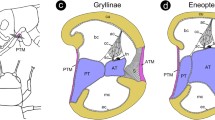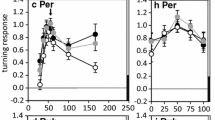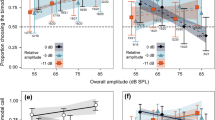Abstract
The acoustic signalling behaviour of many tree cricket species is easily observed and has been well described. Very little is known, however, about the receivers in these communication loops. The exception to this is a single Indian species (Oecanthus henryi) which employs active auditory mechanics to enhance female sensitivity to quiet sounds at male calling frequencies. In most species, male calls have been described, but whether or not sender–receiver matching is present is uncertain. Here we investigate auditory mechanics in females of the North American black-horned tree cricket (Oecanthus nigricornis). The response of the anterior tympanal membrane is nonlinear, exhibiting a lack of tuning at high amplitudes (60 dB and above) but as stimulus amplitude decreases, the membrane becomes tuned to around 4.3 kHz. The tuning of the membrane falls within the frequency range of male calls indicating sender–receiver matching at low amplitudes, which could aid localisation of the highly directional calls of males. The extent of active auditory mechanics in tympanal insects is not yet known, but this paper provides an indication that this may indeed be widespread in at least the Oecanthinae.





Similar content being viewed by others
References
Albert JT, Nadrowski B, Göpfert MC (2007) Mechanical signatures of transducer gating in the Drosophila ear. Curr Biol 17:1000–1006. doi:10.1016/j.cub.2007.05.004
Bell PD (1980) Multimodal communication by the black-horned tree cricket, Oecanthus nigricornis (Walker) (Orthoptera: Gryllidae). Can J Zool 58:1861–1868. doi:10.1139/z80-254
Brown WD (1999) Mate choice in tree crickets and their kin. Annu Rev Entomol 44:371–396
Brown WD, Kuns MM (2000) Female choice and the consistency of courtship feeding in black-horned tree crickets Oecanthus nigricornis Walker (Orthoptera: Gryllidae: Oecanthinae). Ethology 106:543–557
Brown WD, Wideman J, Andrade MCB, Mason AC, Gwynne DT (1996) Female choice for an indicator of male size in the song of the black-horned tree cricket, Oecanthus nigricornis (Orthoptera: Gryllidae: Oecanthinae). Evolution 50:2400–2411
Bussiere LF (2004) Precopulatory choice for cues of material benefits in tree crickets. Behav Ecol 16:255–259. doi:10.1093/beheco/arh151
Eberhard MJB, Gordon SD, Windmill JFC, Ronacher B (2014) Temperature effects on the tympanal membrane and auditory receptor neurons in the locust. J Comp Physiol A. doi:10.1007/s00359-014-0926-y
Fonseca PJ, Correia T (2007) Effects of temperature on tuning of the auditory pathway in the cicada Tettigetta josei (Hemiptera, Tibicinidae). J Exp Biol 210:1834–1845. doi:10.1242/jeb.001495
Forrest TG (1991) Power output and efficiency of sound production by crickets. Behav Ecol 2:327–338
Göpfert MC, Robert D (2001) Active auditory mechanics in mosquitoes. Proc R Soc B Biol Sci 268:333–339. doi:10.1098/rspb.2000.1376
Göpfert MC, Robert D (2003) Motion generation by Drosophila mechanosensory neurons. Proc Natl Acad Sci USA 100:5514–5519. doi:10.1073/pnas.0737564100
Göpfert M, Robert D (2007) Active processes in insect hearing. In: Springer handbook of auditory research: active processes and otoacoustic emissions, vol 30. Springer, New York
Hoy RR, Popper AN, Fay RR (1998) Comparative hearing: insects. Springer, New York
Korsunovskaya OS, Zhantiev RD (2007) Effect of temperature on auditory receptor functions in crickets (Orthoptera, Tettigoniodea). J Evol Biochem Physiol 43:327–334. doi:10.1134/S0022093007030076
Lu Q, Senthilan PR, Effertz T et al (2009) Using Drosophila for studying fundamental processes in hearing. Integr Comp Biol 49:674–680. doi:10.1093/icb/icp072
Manley GA (2000) Cochlear mechanisms from a phylogenetic viewpoint. Proc Natl Acad Sci USA 97:11736–11743. doi:10.1073/pnas.97.22.11736
Manley G, Fay RR, Popper AN (2008) Active processes and otoacoustic emissions. Springer, New York
Mhatre N (2015) Active amplification in insect ears: mechanics, models and molecules. J Comp Physiol A 201:19–37. doi:10.1007/s00359-014-0969-0
Mhatre N, Robert D (2013) A tympanal insect ear exploits a critical oscillator for active amplification and tuning. Curr Biol 23:1952–1957. doi:10.1016/j.cub.2013.08.028
Mhatre N, Montealegre-Z F, Balakrishnan R, Robert D (2009) Mechanical response of the tympanal membranes of the tree cricket Oecanthus henryi. J Comp Physiol A 195:453–462. doi:10.1007/s00359-009-0423-x
Mhatre N, Bhattacharya M, Robert D, Balakrishnan R (2011) Matching sender and receiver: poikilothermy and frequency tuning in a tree cricket. J Exp Biol 214:2569–2578. doi:10.1242/jeb.057612
Mhatre N, Montealegre-Z F, Balakrishnan R, Robert D (2012) Changing resonator geometry to boost sound power decouples size and song frequency in a small insect. Proc Natl Acad Sci USA. doi:10.1016/j.cub.2013.08.028
Nadrowski B, Albert JT, Göpfert MC (2008) Transducer-based force generation explains active process in Drosophila hearing. Curr Biol 18:1365–1372. doi:10.1016/j.cub.2008.07.095
Oldfield BP (1988) The effect of temperature on the tuning and physiology of insect auditory receptors. Hear Res 35:151–158
Riabinina O, Dai M, Duke T, Albert JT (2011) Active process mediates species-specific tuning of Drosophila ears. Curr Biol 21:658–664. doi:10.1016/j.cub.2011.03.001
Robert D (2001) Directional hearing in insects. In: Popper AN, Fay RR (eds) Sound source localization, Springer handbook of auditory research, vol 25. Springer, New York, pp 6–35
Sismondo E (1979) Stridulation and tegminal resonance in the tree cricket Oecanthus nigricornis (Orthoptera: Gryllidae: Oecanthinae). J Comp Physiol A 129:269–279
Sismondo E (1993) Ultrasubharmonic resonance and nonlinear dynamics in the song of Oecanthus nigricornis F. Walker (Orthoptera: Gryllidae). Int J Insect Morphol Embryol 22:217–231
Toms RB (1984) Directional calls and effects of turning behaviour in crickets. J Entomol Soc S Afr 47:309–312
Walker T (1963) The taxonomy and calling songs of United States tree crickets (Orthoptera: Gryllidae: Oecanthinae). II. The nigricornis group of the genus Oecanthus. Ann Entomol Soc Am 56:772–789
Warren B, Lukashkin AN, Russell IJ (2010) The dynein–tubulin motor powers active oscillations and amplification in the hearing organ of the mosquito. Proc R Soc B 277:1761–1769. doi:10.1098/rspb.2009.2355
Williams M (1945) The directional sound waves of Oecanthus nigricornis argentines, or a violinist listens to an insect. Entomol News 56:104
Windmill JFC, Göpfert MC, Robert D (2005) Tympanal travelling waves in migratory locusts. J Exp Biol 208:157–168. doi:10.1242/jeb.01332
Wolf H (1986) Response patterns of two auditory interneurons in a freely moving grasshopper (Chorthippus biguttulus L.). J Comp Physiol A 158:689–696. doi:10.1007/BF00603826
Acknowledgments
The authors would like to thank Natasha Mhatre for helpful discussion and two anonymous reviewers for insightful comments that improved earlier drafts of the manuscript.
Author information
Authors and Affiliations
Corresponding author
Ethics declarations
Experiments were performed in compliance with ethical standards of the institution, and national guidelines for the care and use of animals were followed.
Rights and permissions
About this article
Cite this article
Morley, E.L., Mason, A.C. Active auditory mechanics in female black-horned tree crickets (Oecanthus nigricornis). J Comp Physiol A 201, 1147–1155 (2015). https://doi.org/10.1007/s00359-015-1045-0
Received:
Revised:
Accepted:
Published:
Issue Date:
DOI: https://doi.org/10.1007/s00359-015-1045-0




